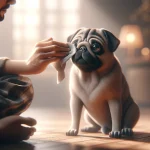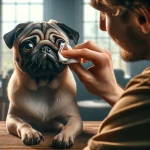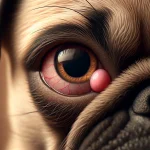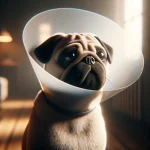Table of Contents
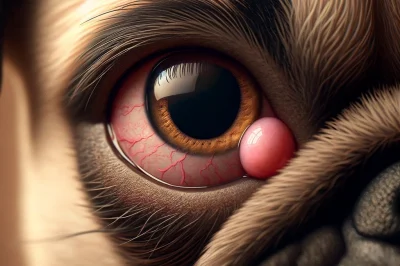
Key Takeaways
- Cherry eye is a common condition in pugs that can be corrected with surgery.
- Early detection and treatment are crucial for the best outcome.
- Pre-surgical preparation involves fasting and a calm environment for your pug.
- Understanding the surgery process can help alleviate anxiety for pet owners.
- Post-operative care is essential for a smooth recovery and includes monitoring and managing your pug’s comfort.
A Peep Into Cherry Eye: A Pug’s Predicament
As a devoted pug parent, you might have heard of cherry eye, a condition that can make your little buddy’s eyes look red and irritated. It’s especially common in pugs, but with the right care, it’s manageable. This guide is here to walk you through understanding what cherry eye is, how it’s treated, and how you can support your pug through the journey to recovery.
What Is Cherry Eye?
Imagine your pug has a tiny, built-in windshield wiper for their eyes – that’s the third eyelid, also known as the nictitating membrane. It’s there to protect and moisturize the eye. Cherry eye happens when the gland in this third eyelid pops out of place, creating a red bulge that looks a bit like a cherry – hence the name. It can be alarming to see, but it’s treatable.
Cherry eye can cause discomfort and lead to more serious issues if not addressed, so it’s important to get your pug checked by a vet if you notice any eye changes.
Why Pugs Are Susceptible
Pugs have those irresistible big, round eyes that make them so endearing. However, their unique eye structure also makes them more prone to cherry eye. The exact reasons aren’t fully understood, but it’s believed that genetics and the shape of their head and eyes play a role. Recognizing the signs early on is key to preventing further complications.
Decoding Cherry Eye Surgery
When it comes to cherry eye, surgery is often the best option. It’s a straightforward procedure where the prolapsed gland is tucked back into place. Some folks might wonder if it’s absolutely necessary, and the answer is usually yes. Left untreated, cherry eye can lead to dry eye, pain, and even damage to the cornea.
Understanding the Procedure
The surgery for cherry eye is quite ingenious. Your vet will create a pocket where the gland can sit securely, preventing it from popping out again. It’s typically a permanent fix, and most pugs bounce back quickly with proper care. The goal is to preserve the gland’s function because it produces a significant portion of the eye’s protective tear film.
Role of Timely Intervention
Acting quickly when you spot cherry eye can make a big difference. Early treatment can prevent secondary issues like infections or corneal damage. Plus, the sooner the gland is repositioned, the better the chances of it functioning normally again.
Now, let’s get your pug ready for a successful surgery with some pre-op pointers.
Seamless Surgery Prep
Prepping your pug for surgery doesn’t have to be stressful. Think of it as getting ready for a little adventure – one that leads to happier, healthier eyes.
Pre-op Must-Do’s for Your Pug
Before surgery, your vet will give you specific instructions, but there are some general steps you can take to ensure your pug is ready:
- Fast your pug for the recommended time before surgery, usually overnight.
- Make sure they have a quiet, comfortable place to relax before heading to the vet.
- Reassure your pug with gentle pets and a calm voice – they can sense your emotions.
Last-Minute Checklist Before Surgery
On the day of the surgery, you’ll want to have a few things in order:
- Confirm the surgery time and any last-minute details with your vet’s office.
- Have your pug’s favorite blanket or toy ready for comfort post-surgery.
- Arrange for a quiet space at home where your pug can recover without disturbance.
Remember, your vet is there to guide you every step of the way, so don’t hesitate to ask questions. With preparation and understanding, you’re setting the stage for a successful surgery and a smooth recovery for your beloved pug.
| Aspect | Pugs with Cherry Eye |
|---|---|
| Recognition | – Swollen and protruding third eyelid resembling a cherry pit |
| – Small, round, pink or red mass in the inside corner of the eye | |
| – Red, itchy, or swollen eye | |
| – Thick mucus discharge from the eye | |
| – Diagnosis through visual examination and tests like Schirmer’s test and fluorescein staining[1][2] | |
| Treatment | – Surgery to return the prolapsed gland into place and prevent relapse |
| – Use of eye drops, medicated ointments, and oral antibiotics to keep the eye moist and prevent infections | |
| Post-Treatment | – Prognosis is good with inflammation subsiding in a week or two |
| – Rest for a few days post-surgery and avoid swimming or bathing for about two weeks | |
| – Recheck by the vet after two weeks and regular ocular exams recommended |
The Big Day: What to Expect During Surgery
So, the day has arrived for your pug’s cherry eye surgery. It’s normal to feel a bit anxious, but knowing what to expect can help ease those nerves. Your vet team is skilled and ready to take the best care of your little one.
Anesthesia and Your Pug’s Comfort
Your pug will be given anesthesia to ensure they are asleep and pain-free during the procedure. This is a routine part of the surgery, and your vet will monitor your pug’s vital signs closely. After the surgery, it might take a few hours for the anesthesia to wear off completely, so your pug may be a little groggy. That’s normal and no cause for alarm.
Most importantly, the vet will have done a thorough pre-anesthetic check to make sure your pug is a good candidate for the procedure. This includes blood tests and sometimes a cardiac evaluation, because safety comes first.
Step-by-Step Surgical Process
The surgery itself is fairly quick. Here’s what happens:
- The vet carefully tucks the prolapsed gland back into its proper place.
- They then secure it with tiny, dissolvable sutures to prevent it from slipping out again.
- The whole process usually takes under an hour, and your pug will be carefully monitored the entire time.
Once the surgery is done, your vet will keep your pug under observation as they wake up from anesthesia. This is to ensure there are no immediate post-op complications.
Road to Recovery
Recovery is an important part of the surgery process. Proper care after the operation can make all the difference in a quick and smooth recovery for your pug. For more detailed guidance, check out our post-surgery comfort guide for the best practices.
First 24 Hours After Surgery
The first day after surgery is crucial. Your pug will likely still be under the influence of the anesthesia and may require extra care and attention. They may be sleepy, unsteady on their feet, or have a decreased appetite. All of this is normal. Ensure they have a comfortable, quiet place to rest without too much stimulation.
Keep an eye on their eye! It should be less red and swollen as the hours pass. If you notice anything out of the ordinary, don’t hesitate to contact your vet.
Monitoring for Possible Complications
Complications are rare, but it’s important to be vigilant. Watch for signs of infection like excessive redness, swelling, or discharge. If the gland prolapses again or if your pug seems to be in pain, it’s time to call the vet. They may prescribe antibiotics or pain relief to help your pug feel better.
Activity Restriction and Healing
For the next few weeks, you’ll need to keep your pug’s activity level low. No rough play or jumping around. This is to ensure the surgical site heals properly and the sutures stay in place. Your vet will let you know when it’s safe for your pug to resume normal activities.
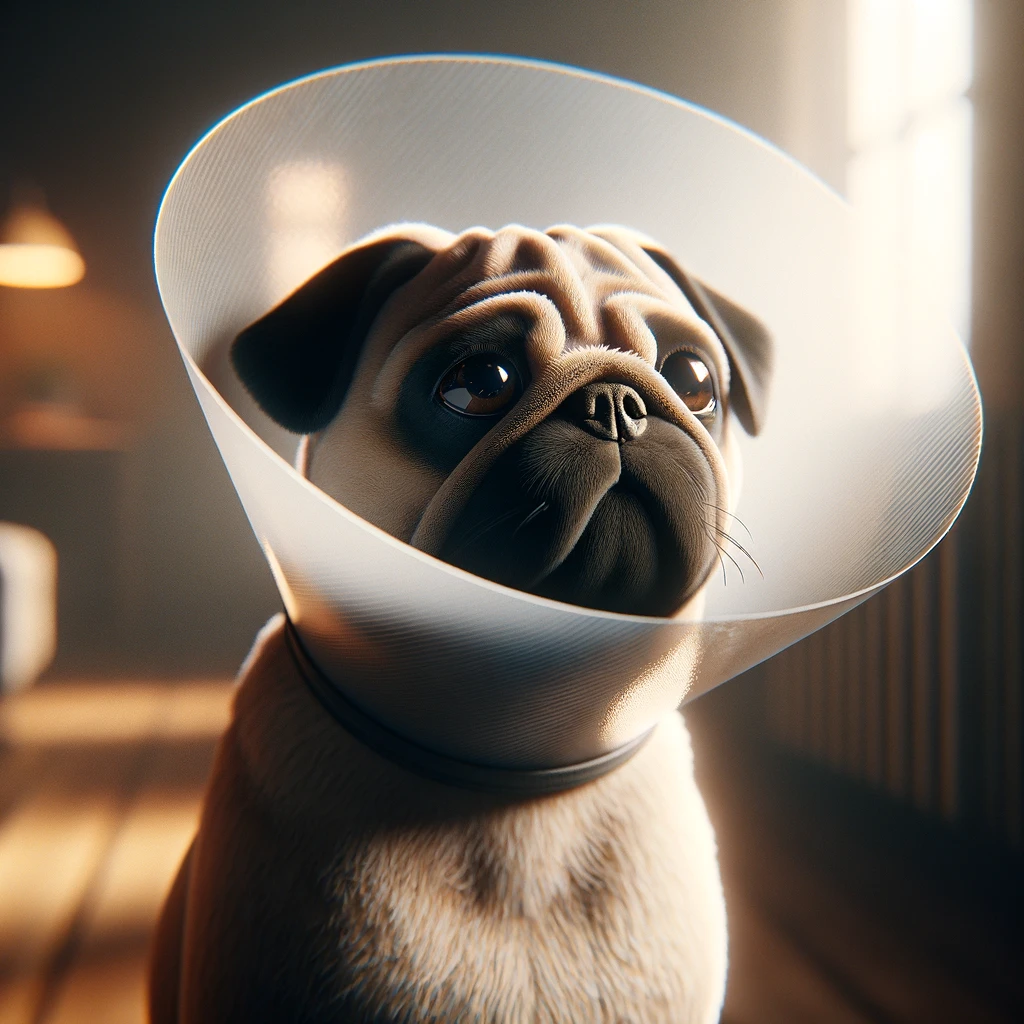
Home Care for Your Convalescing Companion
Once your pug is home, your role as a caregiver kicks into high gear. Here’s how to make sure they have the best possible healing environment.
First off, your pug will need to wear an Elizabethan collar, affectionately known as the ‘cone of shame,’ to prevent them from scratching or rubbing their eye. Yes, they might look a bit funny, and they may not love it, but it’s for their own good.
Keep the home environment calm and stress-free. Set up a comfy recovery area with their bed, favorite blanket, and easy access to food and water.
Pain Management at Home
Your vet may prescribe pain medication to help your pug stay comfortable. It’s important to follow the dosage instructions exactly and to give the medication at the right times. If you’re worried about how your pug is handling the medication or their pain levels, get in touch with your vet.
Most pugs are pretty tough, but they can’t tell us when they’re in pain, so watch for signs like whimpering, restlessness, or a lack of appetite.
Also, be sure to:
- Keep up with any prescribed eye drops or ointments to reduce inflammation and prevent infection.
- Check the surgical site daily for signs of healing or any changes that might need attention.
- Give lots of love and gentle cuddles – they’re a crucial part of the healing process.
Keeping the Surgical Site Safe
It’s vital to keep the surgical site clean and dry. Avoid bathing your pug or letting them get wet in the rain until your vet gives the all-clear. If the area around the eye needs cleaning, use a damp cloth and gently dab around the site, being careful not to touch the eye itself. For more detailed guidance, consider reading this comprehensive guide on post-surgery comfort for pugs.
Nutrition and Hydration Post-Surgery
Good nutrition and staying hydrated are key to your pug’s recovery. They may not feel like eating much right after surgery, but it’s important to encourage them to eat and drink. Offer small, enticing meals and make sure fresh water is always available.
Ensuring a Smooth Sailing Convalescence
With the right care, most pugs recover from cherry eye surgery without any issues. Your vet will schedule follow-up appointments to check on the progress and make sure everything is healing as it should.
Milestones to Watch For
As your pug recovers, you’ll notice the redness and swelling decrease, and their eye will start to look more normal. They should be more active and show interest in their surroundings. These are all good signs that your pug is on the mend.
When to Call the Vet
If you’re ever in doubt about your pug’s recovery, it’s always best to call your vet. They’re there to help and would much rather you call than wait if there’s a potential problem. Trust your instincts – you know your pug better than anyone.
Long-term Management and Care
After recovery, most pugs can go on to live happy, healthy lives without any further eye issues. Keep up with regular vet check-ups and eye exams to catch any potential problems early. Remember, prevention is better than cure.
There you have it – with knowledge, preparation, and a little bit of love, you can navigate cherry eye surgery for your pug like a pro. They’re counting on you, and with this guide, you’re more than ready to support them every step of the way.
Milestones to Watch For
During your pug’s recovery from cherry eye surgery, there are several milestones you should expect. Initially, the eye may appear red and slightly swollen, but this should subside within a few days. Over the following weeks, you’ll notice:
- The eye returning to a more normal appearance, with less redness and swelling.
- Improved comfort levels, with your pug blinking and squinting less.
- An increase in normal behaviors, such as playfulness and curiosity.
Keep a close eye on your pug’s energy levels and appetite, as these are good indicators of their overall well-being. A gradual return to their usual self is a positive sign that recovery is on track. For more detailed information, check out this comprehensive guide on pug eye health.
When to Call the Vet
If you notice any of the following after cherry eye surgery, it’s important to contact your vet:
- Excessive swelling or redness that doesn’t improve or worsens.
- Discharge from the eye, especially if it’s yellow or green.
- Your pug persistently trying to scratch or rub their eye, despite wearing an E-collar.
- Signs of pain such as whining, restlessness, or a decrease in appetite.
These could be signs of infection or that the gland has prolapsed again. Your vet can provide guidance on the next steps, which may include additional treatment or modifications to their recovery plan.
Long-term Management and Care
Once your pug has fully recovered from cherry eye surgery, long-term management is straightforward. Keep up with regular vet visits to monitor their eye health and address any issues early on. Maintain a consistent routine for eye care, including cleaning around the eyes gently and watching for any changes. With good management, your pug should enjoy a comfortable and happy life post-surgery.
FAQs
When it comes to cherry eye surgery in pugs, pet owners often have a number of questions. Here are answers to some of the most frequently asked questions to help you feel more informed and prepared.
How Common Is Cherry Eye in Pugs?
Cherry eye is relatively common in pugs due to their unique facial structure and genetic predisposition. While not every pug will experience this condition, it’s important for pug owners to be aware of it and to regularly check their pet’s eyes for any signs of the problem. For more information on this and other eye conditions that can affect your pug, visit Pug Peepers: A Comprehensive Guide to Eye Health and Conditions.
Can Cherry Eye Occur Again After Surgery?
While the surgery to correct cherry eye has a high success rate, there is a chance of recurrence. Studies show that approximately 5-20% of cases may experience a return of the condition, which may require additional treatment. Following your vet’s post-operative care instructions closely can help minimize this risk.
What Are the Risks of Not Treating Cherry Eye?
Choosing not to treat cherry eye can lead to long-term issues for your pug, including chronic dry eye, irritation, pain, and potential damage to the cornea. Untreated cherry eye can also increase the risk of developing secondary infections or complications.
How Can I Comfort My Pug During Recovery?
Keeping your pug comfortable during recovery is key. Make sure they have a quiet place to rest, and continue to use the E-collar to prevent them from rubbing their eye. Offer gentle affection and keep them engaged with calm activities. If your pug seems particularly uncomfortable, consult your vet for advice on pain management.
Are There Any Alternatives to Surgery?
In some cases, non-surgical options such as massage or medication may be suggested to manage cherry eye, particularly if the condition is mild or temporary. However, these methods are typically less effective than surgery and may not provide a long-term solution. It’s best to discuss all available options with your vet to determine the most appropriate course of action for your pug.

